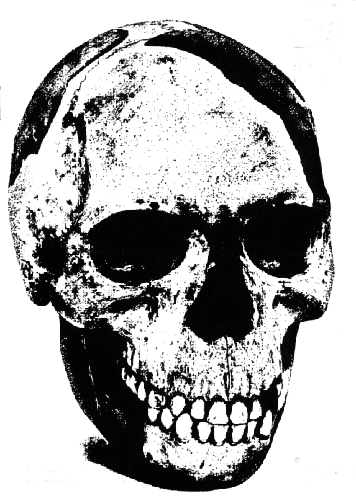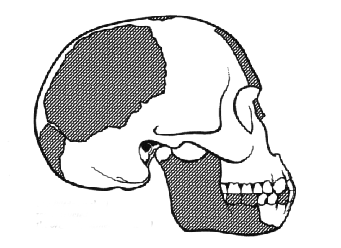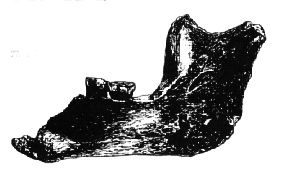
The Piltdown Man Hoax
British Museum (Natural History) 1973

The Piltdown skull as reconstructed by J. H McGregor
[1] The discovery of Piltdown Man
It is difficult to appreciate, some 60 years later, the universal interest and excitement resulting from the announcement of the discovery of the Piltdown remains. At that time the fury of the first controversy generated by the publication of Darwin's Origin of Species by means of Natural Selection in 1859 had begun to subside and be replaced–in the absence of much fossil evidence– by scientific speculation on the anatomy of modern man's ancestors. A few remains of fossil man had been found, the most significant being the discovery of the Java man in 1891. Assessing such evidence as existed at the turn of the century, Dr (later Sir) Arthur Smith Woodward, who was then Keeper of Geology in this Museum, made some predictions regarding the physical features of early man, though his conclusions were by no means universally accepted. Thus, the announcement in 1912 of the occurrence of human remains, conforming with Woodward's predictions, in the gravels of an ancient terrace of the River Ouse in a remote corner of Sussex, was given wide coverage in the press and was the subject of many learned scientific articles and meetings. The discovery had struck a responsive chord in the nationalistic climate of the time – here was an ancient British 'missing-link', which looked as forecast by a British scientist.
The finds themselves were fragmentary–bits of skull and a jawbone. The first skull fragment had been found some time before 1912 by a labourer who had been excavating a patch of gravel at Piltdown, near Fletching, Sussex. It was handed to Charles Dawson, a lawyer and amateur archaeologist who had already observed brown flints in the gravels and had asked the workmen to let him have any fossil bones they might find.
In 1911 Dawson himself claimed to have found another larger piece, belonging to the frontal region, of the same skull. This he took to Dr Woodward at the British Museum (Natural History) for examination. Impressed with the 'fossil', Woodward decided to examine the gravels thoroughly. So it was that in 1912 Dawson and Woodward found more fragments of the skull and in a deeper depression of the undisturbed gravel, Dawson himself found the right half of a jawbone. He judged the findspot to be identical with that upon which the workmen had found the first skull fragment. Woodward then dug up a small portion of the occipital bone of the skull from within a yard of where the jaw was discovered and at precisely the same level. As well as the human remains they found two small broken pieces of a molar tooth of a rather early (Pleistocene) type of elephant, also a much rolled cusp of a molar of Mastodon, portions of two teeth of a later Pleistocene hippopotamus, and two molar teeth of a Pleistocene beaver. The animal bones and teeth appeared to be of two ages, early and [2] late Pleistocene. All the specimens were highly mineralized with iron oxide.

The Piltdown skull reconstructed from the original fragments (shaded)
The discoveries were announced on 18 December 1912 when Dawson and Woodward introduced Piltdown Man to the Geological Society of London.
In the summer of 1913 Woodward and Dawson returned to Piltdown taking the French Jesuit and palaeontologist, Teilhard de Chardin with them. Thus it was Chardin who found the canine tooth, smaller than a normal-sized ape's but distinctly larger than a man's and well worn.
Nothing more was ever found at the original site although the gravels were searched for many years.
Early in 1915 Dawson wrote on a postcard to Woodward that he had found remains of a second skull in a field about two miles from the Piltdown pit. Woodward reported this find in 1917, a year after Dawson's death. Later it proved impossible to identify the field for further search.
First interpretations
At the time of the discovery of the remains of Piltdown Man so little was known about human evolution that it was quite reasonable to believe that in one of the early ancestral types of man the size of the brain-case had approached that of modern man.
[3] Some anatomists identified the Piltdown jaw as that of an ape but it seemed reasonable to regard the jaw as belonging to the skull and representing an extinct 'ape-man' (Eoanthropus dawsoni). The fossil appearance of the skull and jaw were never questioned. When the remains of a second Piltdown Man were reported, including a molar tooth identical with one in the original jawbone and a piece of frontal bone as thick as that of the first skull, most remaining doubters were won over.
But subsequent finds of early man in South Africa (Australopithecus in 1924) and China (Pekin Man in 1928-1937) made it increasingly difficult to accommodate Piltdown Man in any rational scheme of human evolution. These various later finds indicated that the earliest true men and their immediate forebears had jaws which were essentially human. Piltdown Man, if he existed at all, certainly did not occupy a central position in the evolution of man, but rather was 'out on a limb'.
Up to 1949 it seemed either that the jawbone, canine tooth, and skull belonged to the same 'ape-man' who then became extinct, or that the jawbone and canine were those of an extinct ape, which by chance had been preserved close to the skull of a much more recent human skull.
Uncovering the hoax 1949-1953
Relative dating. The fluorine content of fossil bones and teeth is a very useful means of establishing the relative antiquity of specimens of several ages when they occur under similar conditions at the same or adjacent sites. Fluorine, present in minute traces in groundwaters, is absorbed by bone and dentine. Thus the fluorine content of skeletal remains buried in permeable ground increases with time. And bones artificially interred in a deposit will have much less fluorine than those bones which were buried when the deposit was laid down. In 1949 Dr K. P. Oakley applied the fluorine test to the Piltdown bones expecting to obtain proof that the skull and jawbone were contemporary with the earliest fossils. The actual results were very different. All the undoubted later Pleistocene fossils showed less fluorine than the early but a greater range (0.1-1.5 per cent late; 1.9-3.1 per cent early) than would be expected from a single age group. But most surprisingly the skull, jawbone and canine tooth proved to have very little fluorine (< 0.1-0.4 per cent). Neither the brain-case nor the jawbone was of the great antiquity previously claimed.
Chemical and physical evidence. The X-ray photograph of the canine tooth showed that the pulp cavity had been packed with sand-grains about I mm in diameter. If these had infiltrated naturally they would have been accompanied by smaller grains which are equally abundant in the sand fraction of the Piltdown gravel.
[4] The tooth had a dark coating previously attributed to iron oxides which on examination proved to be a paint, probably Vandyke brown.
The dark brown colour of the jawbone is mainly due to iron-staining but the detection of large traces of chromium in addition was one of the first indications that the bone was fraudulent.
The skull fragments were known to have been dipped in potassium dichromate, with the mistaken idea that this would harden them. As the jawbone was found in Woodward's presence, and would have been taken by him straight to the Museum, it is difficult to see how the jawbone could have been dipped in a chromate solution, except on some occasion prior to its reported discovery, that is unless it had been 'planted'.
In fact, the most surprising feature of the skull fragments was their high content of gypsum (Ca
5SO4.2H2O) which replaced much of the apatite (Ca5(PO4)3 OH), a feature hitherto unrecorded for bone. It was shown by experiment in the Museum that human bone could be coloured to resemble the Piltdown specimen by soaking in a solution of iron sulphates, and that such treatment resulted in the conversion of much of the apatite to gypsum. Gypsum is also widely distributed in the bones of other animals collected at the Piltdown site. Replacement of phosphate by sulphate in this way would be most unlikely in soil except perhaps in the region of a sulphide ore-body in process of active weathering, and certainly impossible in the vicinity of Piltdown.Relatively large amounts of chromium (up to 2.0 per cent) were found to be present in the stains on several of the fossil animal teeth, on a fossil animal bone and on one of the flint artifacts–not a specimen in need of hardening. No comparable traces of chromium could be detected in the Piltdown gravel. It seems that the 'hoaxer' used chromium compounds to assist the oxidation of the iron salts with which he was staining specimens to match the reddish-brown gravel at Piltdown.

Fossil bone 'implement'
A further problematical and unique blade-like 'implement' which had been found under a hedge at Piltdown in 1914 had always been regarded as something of a puzzle since nothing like it was known from any other Palaeolithic site. Made out of bone from the femur of a large extinct elephant it is pointed at one end and rounded at the other by a series of cleanly cut facets. Comparative tests on other fossil bones showed these facets to have been made not by a flint knife on fresh bone as originally contended but by a steel knife on fossilised bone.
[5] Anatomical evidence. In August 1953 Dr J. S. Weiner pointed out that only one feature distinguished the Piltdown jawbone from that of a modern ape. This was the wear of the molar teeth. In human jaws the molars commonly wear down to a relatively flat surface (especially with primitive 'herd' diets) at a fairly early age, but not so in apes. The features of the biting surface of the Piltdown molars can only be explained by artificial grindings. The flatness is far too even all over and the planes are un-naturally out of line with one another.
An X-ray photograph of the canine tooth showed that it is a young tooth that had only just erupted at the time of the owner's death; yet it has been worn down so far that at one point the pulpcavity has been reached and a hole produced.
The jaw, identified as that of a young orang-utan, was carefully broken near the midline so that the true nature of the chin could only be guessed. The point where the jaw joins the skull was also broken to hide the fact that in life it had chewed in an up and down direction, not in the more rotating direction found in man (the action which produces flat wear on the molar teeth).

The Piltdown jawbone
The fabrication of 'Piltdown II' The right frontal fragment of the 'second' skull must originally have formed part of the first cranium, which was presumably chosen as the basis of the hoax because of its exceptional thickness, believed at that time to be a primitive feature. The skull was broken up in such a way that selected pieces were difficult to reconstruct. A piece of the left frontal bone was used to form part of the 'first' skull while a fragment of the right frontal was kept back and later placed with a piece of occipital bone from a second and more usual skull, cut down to duplicate as far as possible the thinnest part of the occipital bone of the first cranium.
[6] These two fragments after being chemically treated until they matched, were grouped with an artificially abraded molar tooth of an ape, probably one from the discarded part of the original Piltdown jawbone.
Conclusions
Not one of the finds genuinely came from Piltdown.
Of the eighteen fossils tested more than half show unquestionable signs of having been stained to match the gravel. They are of several different ages and were gathered from a wide variety of sources, some of them foreign.
Subsequent radiocarbon dating of the skull fragments (unusually thick, but not pathological) indicates a date about 1330 AD (620 plus or minus 100 BP GrN–2203) and of the jawbone (of young orang-utan) a date about 1450 AD (500 plus or minus 100 BP GrN–2204).
None of the Eoanthropus fragments can be considered fossil or in any way part of man's ancestry.